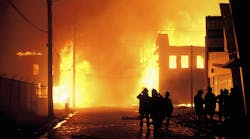The study compared the health conditions of those who worked on rescue and recovery with medical test results from the previous five years.
FDNY rescuers who sucked in toxic air while working at Ground Zero lost the equivalent of 12 years of lung function after the World Trade Center attacks, a bombshell health study shows.
"World Trade Center exposure produced a substantial reduction in pulmonary function in New York City Fire Department rescue workers during the first year following 9/11/01," according to the analysis of 12,079 fire and EMT workers conducted by Montefiore Medical Center-Einstein College and the FDNY.
The respiratory loss "equaled 12 years of aging-related decline," the report said.
The study compared the health conditions of the FDNY responders who worked on rescue and recovery efforts with their medical test results from the previous five years.
Each of the responders underwent testing to determine lung and respiratory capacity before and after 9/11. The exam tallies forced expiratory volume (FEV) - or how much a person can exhale during a breath.
Typically, an adult loses 31 milliliters in FEV per year. But Ground Zero workers lost 372 milliliters - a rate of decline 12 times the normal annual rate.
"There was a drop in lung function equivalent to 12 years of aging," said co-author Dr. Gisela Banauch, a professor at Montefiore/Einstein College in The Bronx. "It's statistically a very significant loss."
"This study - together with other studies that have been published - makes a causal connection between WTC exposure and short- to intermediate-term respiratory disease very likely," Banauch told The Post of the findings, published in the American Journal of Respiratory Critical Care Medicine.
The loss in lung function is "tied to sickness and death," she added.
The 12-year loss is just an average. Thousands of firefighters who were present during the collapse of the Twin Towers suffered the greatest loss of respiratory capacity (388 milliliters), the study found.
The FDNY's chief medical officer, Dr. David Prezant, who is a study co-author and Einstein College professor, considered the discrepancy in the rate of illnesses - based on when firefighters and EMTs arrived at the disaster site - the most significant scientific finding. Pollution and debris were most prevalent when the buildings crashed, and dissipated in time.
"The closer you were to the morning of the collapse," Prezant said, "the worst drop in symptoms and pulmonary function."
Prezant stressed that the dramatic 12-year loss in breathing functions in one year was a snapshot in time and doesn't necessarily mean a 40-year-old ends up with the lungs of a 52-year-old.
"It doesn't mean this is irreversible loss. Early diagnosis and aggressive treatment has been restoring a large portion of the lung function. There's been great improvement," he said.
A follow-up analysis will be conducted to determine whether breathing functions recover or worsen for each FDNY rescue worker.
Lawyers representing sick Ground Zero rescue workers in a negligence suit filed against the city hailed the report's findings.
"It shows what a massive impact this disaster had on first responders. Usually it takes years or decades for diseases to show themselves. Here, you have acute health effects shortly thereafter. What does this tell us about the future?" said attorney Andrew Carboy of Sullivan, Papain, Block, McGrath & Cannavo.
And Carboy said the study also provides crucial evidence showing that government officials in charge of Ground Zero failed to provide safety gear to protect workers from inhaling hazardous air and dust - a major claim of plaintiffs in the case.
The study noted that more than 400 chemicals were identified in the toxic WTC air.
"Adequate respiratory protection was not immediately available," the report said, adding that only 22 percent of workers who first arrived to the disaster site wore masks. Among responders who came later, the figure never topped 50 percent.
Even so, the protective respiratory equipment that was used "had no appreciable effect," the study said. "No doubt, the initial lack of adequate equipment and subsequent compliance problems diminished any protective impact," it said.





